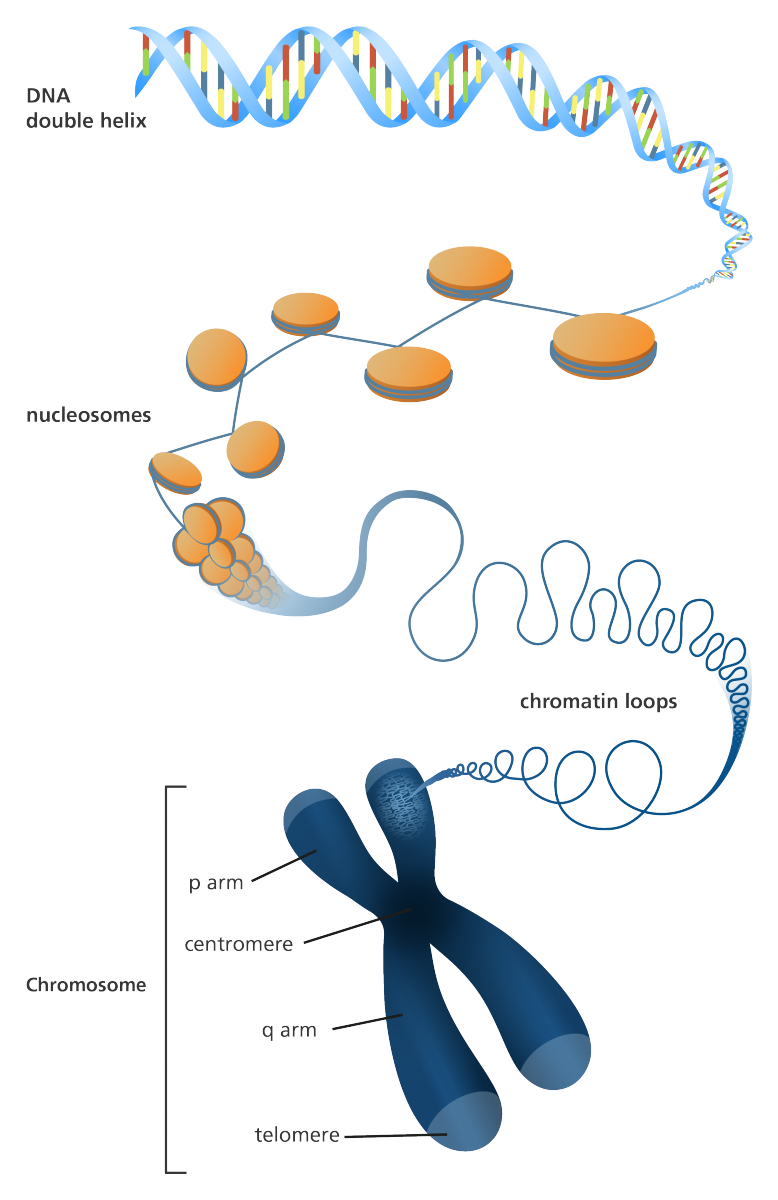
Nucleus
The nucleus is the most important organelle in a cell because it holds deoxyribonucleic acid (DNA).
Organelle (n.): specialized structures within a living cell
It coordinates the day-to-day functions of the cell.
Nuclear Structure
The nuclear envelope is a double membrane; it’s similar to the cell membrane, except the nuclear membrane is made of two distinct membranes and pores known as nuclear pores.
The double membrane and pores allow things like messenger RNA (mRNA) to exit the cell, taking the instructions for proteins to the ribosomes where proteins are made. The mRNA is needed because the DNA is too large and important to ever leave the nucleus. If a ribosome needs the instructions in DNA, the mRNA will take the instructions in that specific snippet of DNA to the ribosome.
Ribosomes and ribosomal RNA (rRNA) are made in the nucleolus, which is in the center of the nucleus.

DNA
DNA is the genetic material in a cell and holds the instructions for the cell.
DNA can be “read” and holds the instructions that tell the cell which proteins to produce. Proteins are used for almost all of the tasks in a cell and do whatever the cell instructs them to do. Some examples of proteins are hemoglobin and enzymes.
A typical eukaryotic cell can hold around 3.5 feet of DNA in its nucleus. This is a lot of genetic material given that a cell is only 10-100 micrometers, or about 9 times shorter than the length of DNA. Because of its large size, DNA is too long to go in and out of the nucleus every time the cell needs to make a protein, thus the mRNA takes segments of DNA to the ribosome to make proteins as they are needed.
When a cell is not reproducing, DNA is spread out in the form of chromatin. Chromatin is thin and wispy, similar to yarn. This makes it easy for the cell to access the DNA as it is needed.
When the cell is ready to reproduce, it forms chromosomes. Chromosomes are condensed chromatin that make it easier for the DNA to be separated during replication.
In order to fit the DNA into chromosomes, the DNA must supercoil. This means that the DNA is wrapped around a protein histone to make a nucleosome and then the nucleosomes are wrapped together. DNA is easier to move around for replication when it is condensed into chromosomes.
In other words, chromosomes are made when DNA supercoils around histones, forming nucleosomes.
 Edited: 05 October 2022
Edited: 05 October 2022
Nucleus
The nucleus is the most important organelle in a cell because it holds deoxyribonucleic acid (DNA).
Organelle (n.): specialized structures within a living cell
It coordinates the day-to-day functions of the cell.
Nuclear Structure
The nuclear envelope is a double membrane; it’s similar to the cell membrane, except the nuclear membrane is made of two distinct membranes and pores known as nuclear pores.
The double membrane and pores allow things like messenger RNA (mRNA) to exit the cell, taking the instructions for proteins to the ribosomes where proteins are made. The mRNA is needed because the DNA is too large and important to ever leave the nucleus. If a ribosome needs the instructions in DNA, the mRNA will take the instructions in that specific snippet of DNA to the ribosome.
Ribosomes and ribosomal RNA (rRNA) are made in the nucleolus, which is in the center of the nucleus.

DNA
DNA is the genetic material in a cell and holds the instructions for the cell.
DNA can be “read” and holds the instructions that tell the cell which proteins to produce. Proteins are used for almost all of the tasks in a cell and do whatever the cell instructs them to do. Some examples of proteins are hemoglobin and enzymes.
A typical eukaryotic cell can hold around 3.5 feet of DNA in its nucleus. This is a lot of genetic material given that a cell is only 10-100 micrometers, or about 9 times shorter than the length of DNA. Because of its large size, DNA is too long to go in and out of the nucleus every time the cell needs to make a protein, thus the mRNA takes segments of DNA to the ribosome to make proteins as they are needed.
When a cell is not reproducing, DNA is spread out in the form of chromatin. Chromatin is thin and wispy, similar to yarn. This makes it easy for the cell to access the DNA as it is needed.
When the cell is ready to reproduce, it forms chromosomes. Chromosomes are condensed chromatin that make it easier for the DNA to be separated during replication.
In order to fit the DNA into chromosomes, the DNA must supercoil. This means that the DNA is wrapped around a protein histone to make a nucleosome and then the nucleosomes are wrapped together. DNA is easier to move around for replication when it is condensed into chromosomes.
In other words, chromosomes are made when DNA supercoils around histones, forming nucleosomes.
 Edited: 05 October 2022
Edited: 05 October 2022
 Knowt
Knowt
